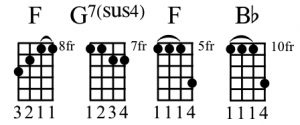There’s a neat little trick at the end of the solo in Steve Miller’s The Joker. While the backing guitar plays a C chord, the lead guitar slides into an F chord. The two chords blend together to make a much more interesting sound than they do individually.
Stacked chords like these are known as polychords and there’s a lot of potential for them on ukuleles where chords are limited to four notes per uke.
Here’s the averagest chord progression possible: C – G – C – G
Incalculably boring, I trust you’ll agree. Here’s another one: Em – Bm – Em – Bm
Also very boring. But if you play them both at the same time you get this:
The two ukes blend together to create the progression: Cmaj7 – Gmaj7 – Cmaj7 – Gmaj7.
You can pull this trick with any major chord. When you combine a major chord with a minor chord a third higher (i.e. the root note is four frets higher) you get a major 7 chord. For example:
F + Am = Fmaj7
D + F#m = Dmaj7
Bb + Dm = Bbmaj7
The Theory
The theory behind it is pretty simple. Each major and minor chord is made up of three notes. In the example of C and Em they’re:
C chord: C – E – G
Em chord: E – G – B
And Cmaj7 contains four notes:
Cmaj7 chord: C – E – G – B
Blending the C, E and G with the B from the Em gives you all the notes you need for a Cmaj7 chord.
Getting Fancier
You might already be familiar with maj7 chords and already playing them. But what about 9 chords (Prince’s favourite chord) that contain five notes? Playing them on one uke you have to ditch one of the notes. But by stacking chords you can create them by playing a major chord along with a minor chord a fifth above it.
In this example the left panned ukulele is playing:
C – F – C – F
And the right:
Gm – Cm – Gm – Cm
These combine to create:
C9 – F9 – C9 – F9
Some other chord combinations that produce this sound:
A + Em = A9
D + Am = D9
G + Dm = G9
Up the Neck
So far all the chords I’ve used have been the bog-standard, from-the-book shapes. But you can use this technique to the fullest by using chord inversions up the neck. That’ll give you a much wider range of notes in the chord.
Here’s another boring progression: C – F – G – C
And here are the same chord shapes played with the capo at the 7th fret (so the actual progression is G – C – D – G):
Combine those and you get the progression Cmaj7add9 – Fmaj7add9 – Gmaj7add9 – Cmaj7add9
You can pull the same trick by playing any major chord with the same chord played at the 7th fret stack on top.
Taking it a bit further, here’s a progression based on Purple Rain:
First uke: Bb – Gm7 – F – Eb (using the standard shapes).
Second uke: F – G7sus4 – F – Bb
To create the slightly crazy progression Bmaj7add9 – Gm7add11 – F – Ebmaj7add9. Which sounds like this:
Putting It Into Practice
Some of the stuff in this post is definitely on the technical side. And I’d recommend using it a lot more sparingly than I have in these examples. But I hope it’s given you a few ideas to spice up playing with more than one uke and encouraged you to experiment. There are so many possibilities it’s a shame to have every uke playing the same thing all the time.




Great stuff, Al!